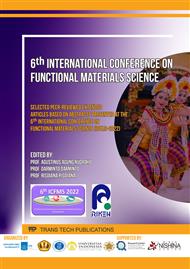p.1
p.7
p.13
p.19
p.25
p.35
p.51
p.65
Fabrication of Densely-Packed Janus Gold Nanoparticles Layer by Self-Assembly for a Potential Molecular Sensing Probe
Abstract:
Localized surface plasmon phenomena of metallic nanoparticles could be utilized for sensing applications. As the particles in the vicinity results in a near-field coupling phenomenon, a higher field enhancement factor increases the sensing sensitivity. In this research, we propose a self-assembled and closely-packed Janus gold nanoparticle (AuNP) structure for application in molecular sensing. We utilize three-phase interfacial trapping and Langmuir-Schaefer method for the fabrication of Janus AuNP layer. In our case, dodecylamine (DDA) was used as the analyte for sensing assay. We found that the color of our AuNP changes from red-wine to blue in conjunction with the phase changes from colloidal to closely-packed layer that results in a red-shift absorbance peak. In the application of sensing assay, the absorbance peak is revealed blue-shifted up to ~40 nm from pristine AuNP layer due to the adsorption of DDA on the particle surfaces. Sensitivity enhancement is also expected due to the hotspot arises from the plasmonic particles in vicinity. This research could be further developed to a sensitive and quantitative molecular sensor up to colorimetric specific biosensor.
Info:
Periodical:
Pages:
19-24
Citation:
Online since:
July 2023
Price:
Сopyright:
© 2023 Trans Tech Publications Ltd. All Rights Reserved
Share:
Citation:



